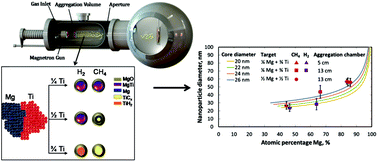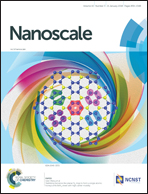Shape and structural motifs control of MgTi bimetallic nanoparticles using hydrogen and methane as trace impurities†
Abstract
In this work we report the influence of methane/hydrogen on the nucleation and formation of MgTi bimetallic nanoparticles (NPs) prepared by gas phase synthesis. We show that a diverse variety of structural motifs can be obtained from MgTi alloy, TiCx/Mg/MgO, TiCx/MgO and TiHx/MgO core/shell NPs via synthesis using CH4/H2 as a trace gas, and with good control of the final NP morphology and size distribution. Moreover, depending on the concentration of Ti and type of employed trace gas, the as prepared MgTi NPs can be tuned from truncated hexagonal pyramid to triangular and hexagonal platelet shapes. The shape of MgTi NPs is identified using detailed analysis from selected area electron diffraction (SAED) patterns and tomography (3D reconstruction based on a tilt series of Bright-Field transmission electron microscopy (TEM) micrographs). We observe the truncated hexagonal pyramid as a shape of MgTi alloy NPs in contrast to Mg NPs that show a hexagonal prismatic shape. Moreover, based on our experimental observations and generic geometrical model analysis, we also prove that the formation of the various structural motifs is based on a sequential growth mechanism instead of phase separation. One of the prime reasons for such mechanism is based on the inadequacy of Mg to nucleate without template in the synthesis condition. In addition, the shape of the TiCx/TiHx core, and the concentration of Mg have strong influence on the shape evolution of TiCx/MgO and TiHx/MgO NPs compared to TiCx/Mg/MgO NPs, where the thermodynamics and growth rates of the Mg crystal planes dominate the final shape. Finally, it is demonstrated that the core shape of TiCx and TiHx is affected by the Mg/Ti target ratio (affecting the composition in the plasma), and the type of the trace gas employed. In the case of CH4 the TiCx core forms a triangular platelet, while in the case of H2 the TiHx core transforms into a hexagonal platelet. We elucidate the reason for the TiCx/TiHx core shape based on the presence of (i) defects, and (ii) hydrogen and carbon adsorption on {111} planes that alter the growth rates and surface facet stabilization.



 Please wait while we load your content...
Please wait while we load your content...